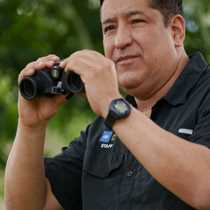Yanalpa Caño & El Dorado River
We awoke again to a beautiful shiny morning, and it felt great! We explored Yanallpa Caño, a relatively small tributary of the Uyacali River. In this location we devoted our time looking for wildlife.
In this creek we had several interesting sightings as well. The highlights were a Roadside hawk (Buteo magnirostris) perching quietly on a river branch and several Brown- throated Three-toed sloths (Bradypus variegatus) moving slowly on top of high trees. The behavior of this solitary mammal species is eminently curious in many ways. Sloths feed very high in the forest canopy, where they are very camouflaged and difficult to see. On the ground they are helpless, and virtually unable to walk due to their famous slowness. They have a peculiar ritual for an arboreal critter; they descend from time to time (approximately once a week) to the ground to defecate. While hanging down from a tree branch dig a hole with its tail, defecate in it and cover it over.
Night monkeys (Aotus vociferans) and Saki monkeys (Phitecia monachus) deserve special attention in this note as well. We had extraordinary good sightings of these two fairly unknown monkey species. Sakis were seen at relatively close range while coming down from a tree and a family of Night monkeys was seen just some feet away from our heads!
We returned for breakfast, which was followed by another natural history talk by me, “The Ecology and Morphology of the Primates of the Upper Amazon.”
In the afternoon we visited the second location of the day, “El Dorado” River. We found a raucous flock of hoatzins (Ophistocomus hoazin). This bird species is by far one of the most interesting of the Amazon. Hoatzins when young have claws. For me the real highlight was the chance to remain in silence for a long time enjoying the intrinsic beauty of the solitude that this remote location evokes.
As little by little the sun started to fade we made our way back to the ship. We came back with the aid of a big spotlight operated by our naturalists to see nocturnal wildlife. We spotted a species of bird similar to night jars called pauraques that eat insects and a relative of these called the Great Potoo, a much larger owl-size insect eater. Many fishing bats were flying up and down the creek, echo locating for fish off the ripples fish make as they come to the surface to catch insects. The icing on the cake was the unusual sighting of a very large caiman alligator that caused sensation among their astonished observers. We also found small spectacled caimans in the floating vegetation. These are the most common caiman in South America and a member of the Alligator family. Everyone came home thrilled at having experienced the transition from day to night and watching the nocturnal environment unfold.




